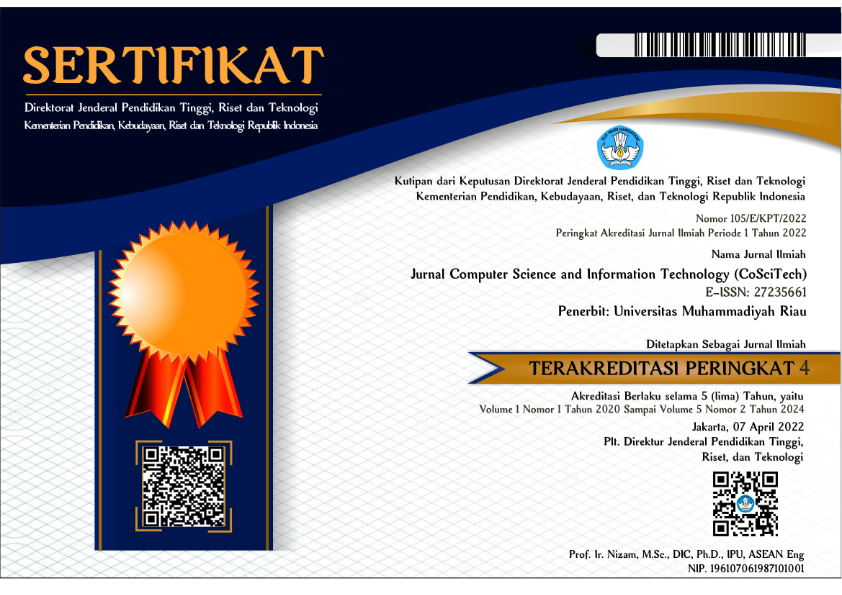Implementasi Algoritma Apriori dan ECLAT (Equivalence Class Transformation) Pada Data Transaksi Penjualan
DOI:
 https://doi.org/10.37859/coscitech.v4i2.5444
https://doi.org/10.37859/coscitech.v4i2.5444
Abstract
Vhe Pagaralam Minimarket is an individual owned minimarket that is managed privately and is engaged in food retail business activities and various kinds of daily needs. However, in several cases consumers complained about difficulties in finding the desired goods and complaints about several food products such as noodles and wheat flour which were contaminated with odors from non-food products such as rinso. Therefore, recommendations for better layout of goods are needed by taking into account the purchasing patterns formed by consumers when shopping. This study aims to provide recommendations for the layout of goods based on the results of the rules that are formed. The method used is the association rule by utilizing the a priori algorithm and the ECLAT (Equivalence Class Transformation) algorithm to find out the comparison of the results of the rules of the two algorithms. Based on the rules formed, this study resulted in 10 food products that were suggested to be placed side by side, especially 1L Bulk Oil, 1/2kg Eggplant and 1kg Ordinary Wheat Flour because they have a certainty value of 97%. For non-food products, there are 9 products that are recommended to be placed side by side, especially Fress Bath Soap, Daia Powder Violet Bag, Pepsodent Action 123 Herbal and Mama Lemon 55ml because they have a certainty value of 93%. The results of establishing the rules can be used as a reference for preparing the layout of goods at the Vhe Pagaralam minimarket.
Downloads
References
[2] N. Hendrastuty, A. A. Aldino, F. H. A. Ferico, and O. Pasaribu, “PENERAPAN ALGORITMA ECLAT DAN APRIORI PADA DATA MINING UNTUK MARKET BASET ANALISIS,” vol. 3, no. 2, 2022.
[3] S. Sulastri, E. Zuliarso, and Y. Anis, “Implementasi Algoritma Apriori Dan Algoritma Eclat Pada Ahass Akmal Jaya Purwodadi,” Dinamik, vol. 22, no. 1, pp. 50–56, 2018, doi: 10.35315/dinamik.v22i1.7105.
[4] R. S. Yudha, K. Auliasari, and R. P. Prasetya, “Penjualan Produk Bangunan,” J. Mhs. Tek. Inform., vol. 4, no. 1, pp. 154–161, 2020.
[5] L. Lisnawita and M. Devega, “Analisis Perbandingan Algoritma Apriori Dan Algoritma Eclat Dalam Menentukan Pola Peminjaman Buku Di Perpustakaan Universitas Lancang Kuning,” INOVTEK Polbeng - Seri Inform., vol. 3, no. 2, p. 118, 2018, doi: 10.35314/isi.v3i2.753.
[6] M. P. Mahardika, Y. H. Chrisnanto, and F. Renaldi, “Analisis Perbandingan Kinerja Algoritma ECLAT dan Apriori Dalam Pembentukan Aturan Asosiasi Pada Pasar Pertanian Online,” pp. 9–15, 2021.
[7] S. Sudarsono, A. Wijaya, and A. Andri, “Perbandingan Algoritma Eclat Dan Fp-Growth Pada Penjualan Barang (Studi Kasus: Minimarket 212 Mart Veteran Utama),” Bina Darma Conf. Comput. Sci., vol. 1, no. 1, pp. 208–217, 2019, [Online]. Available: https://conference.binadarma.ac.id/index.php/BDCCS/article/view/107.
[8] E. T. L. Kusrini, Algoritma Data Mining. Yogyakarta: Andi Offset, 2009.
[9] J. Han, M. Kamber, and J. Pei, “Konsep dan Teknik Data Mining Data Preprocessing,” Buku, 2021.
[10] A. N. Rahmi and Y. A. Mikola, “Implementasi Algoritma Apriori Untuk Menentukan Pola Pembelian Pada Customer (Studi Kasus : Toko Bakoel Sembako),” Inf. Syst. J., vol. 4, no. 1, pp. 14–19, 2021, [Online]. Available: https://jurnal.amikom.ac.id/index.php/infos/article/view/561.














